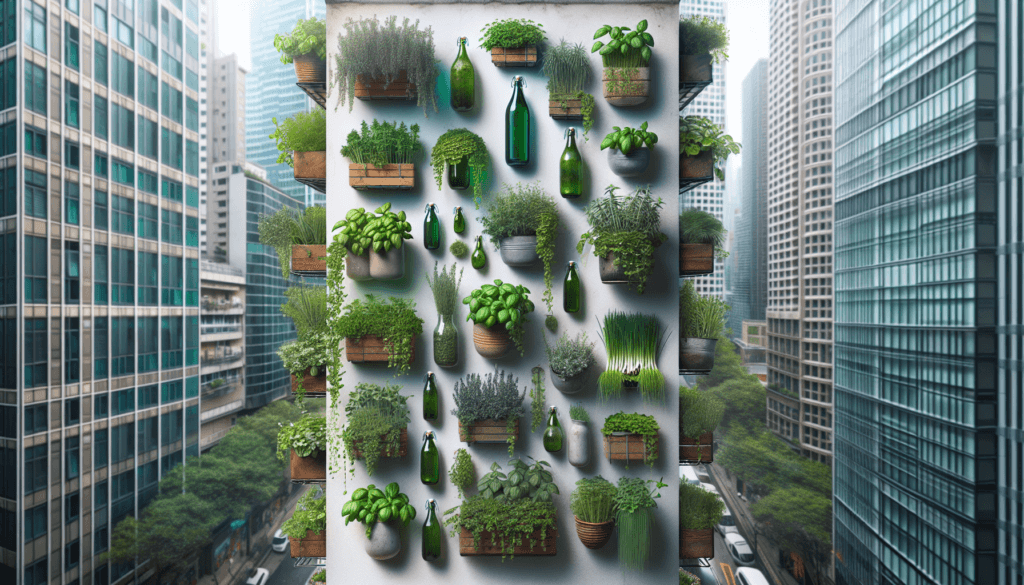Are you limited on space in your urban environment but still want to enjoy fresh herbs? Look no further! This article will guide you on how to create a vertical herb garden in even the smallest of spaces. With a few simple steps, you can have a beautiful and practical herb garden right in your own home, allowing you to easily add flavor and freshness to your cooking. Say goodbye to store-bought herbs and hello to your own urban oasis of greenery!
Choosing the Right Location
Assessing available space
When creating a vertical herb garden in a small urban space, it’s crucial to assess the available space before getting started. Look for areas that receive adequate sunlight and have enough room to accommodate your chosen vertical structure and herb plants. Consider utilizing unused vertical space such as walls, fences, or balconies to maximize your growing area.
Considering sunlight requirements
Herbs generally require at least 6-8 hours of direct sunlight daily to thrive. Therefore, it’s essential to choose a location for your vertical herb garden that receives adequate sunlight throughout the day. Observe the area at different times to ensure it meets the sunlight requirements of your selected herbs. If your chosen space lacks sufficient sunlight, consider using artificial grow lights to supplement the natural light.
Evaluating accessibility
Another crucial factor to consider when choosing a location for your vertical herb garden is accessibility. Ensure the area is easily accessible for watering, tending to the plants, and harvesting the herbs. Avoid areas that may be obstructed or out of reach. Accessibility will make it much more convenient for you to care for your herb garden and enjoy the fruits of your labor.
Determining the Plant List
Selecting suitable herbs
When determining the plant list for your vertical herb garden, consider selecting herbs that are well-suited to small urban spaces. Some popular choices for vertical gardens include basil, thyme, rosemary, mint, and parsley. These herbs are relatively compact, have shallow root systems, and can thrive in containers or hanging baskets. Choose herbs that you enjoy using in your culinary creations and have similar growth requirements to simplify care.
Understanding growth requirements
Before finalizing your plant list, make sure to understand the growth requirements of the herbs you’ve selected. Consider factors such as water and nutrient needs, preferred soil type, and temperature tolerance. Some herbs, like basil, prefer consistently moist soil, while others, like rosemary, prefer drier conditions. Understanding these requirements will help you provide the ideal growing environment for your herbs.
Considering aesthetic appeal
In addition to selecting herbs based on their growth requirements, it’s also essential to consider their aesthetic appeal. Choose herbs with different textures, colors, and leaf shapes to create visual interest in your vertical herb garden. Mixing trailing herbs with upright varieties can add dimension and create a more dynamic display. By considering both the practicality and the beauty of your herb choices, you can create a visually pleasing and functional garden.

Planning the Vertical Structure
Exploring different vertical gardening options
There are several options to choose from when planning the vertical structure for your herb garden. Popular choices include vertical planters, trellises, hanging baskets, and even repurposed items such as pallets or shoe organizers. Research different vertical gardening options and select one that suits your available space, aesthetic preferences, and budget. Consider the materials used, durability, and ease of installation when making your decision.
Considering wall-mounted systems
Wall-mounted systems are a great option for small urban spaces with limited floor area. These systems allow you to create a vertical garden directly on a wall or fence. Look for wall-mounted gardening kits or DIY solutions that provide sturdy support for your herb plants. Ensure the system you choose allows for proper drainage and offers enough space for your herbs to grow comfortably.
Opting for freestanding structures
If you have more floor space available, freestanding structures can provide an excellent solution for your vertical herb garden. Consider freestanding planters, plant stands, or tiered shelving units that can accommodate multiple herb plants. These structures offer versatility, as they can be easily moved and rearranged as needed. Choose freestanding structures that are sturdy and stable to prevent accidental tipping or damage.
Preparing the Growing Medium
Selecting appropriate containers
When creating a vertical herb garden, it’s essential to select appropriate containers for your plants. Choose containers that are the right size for the herb’s root system and have proper drainage holes to prevent waterlogging. Additionally, consider materials that won’t degrade over time, such as plastic, ceramic, or metal containers. Hanging baskets, window boxes, and pocket planters are also great options for vertical gardening.
Choosing the right soil mix
Selecting the right soil mix is crucial for the success of your vertical herb garden. Herbs generally prefer well-draining soil with good moisture retention. Opt for a high-quality potting mix that is lightweight, fertile, and well-aerated. Avoid garden soil, as it tends to be heavy and may not provide adequate drainage. Consider adding organic matter or compost to improve the soil’s fertility and moisture-holding capacity.
Adding amendments for drainage and fertility
To ensure optimal growth for your herbs, it’s beneficial to add amendments to the soil to improve drainage and fertility. Perlite or vermiculite can be mixed into the potting mix to enhance drainage and prevent waterlogging. Additionally, incorporating organic fertilizers or slow-release granules can provide essential nutrients for your herbs throughout the growing season. Follow the recommended application rates for the specific fertilizers you choose.

Planting and Installing the Herb Garden
Spacing plants correctly
Proper spacing between herb plants is essential to promote healthy growth and prevent overcrowding. Different herbs have varying growth habits, so it’s crucial to research the specific spacing requirements for each herb in your garden. Giving each plant enough space ensures adequate airflow, reduces the risk of disease, and allows access for watering and harvesting.
Planting techniques for vertical gardens
Planting techniques for vertical herb gardens can vary depending on the chosen structure. For wall-mounted systems, it’s essential to ensure proper stability and secure the containers to the structure firmly. Follow the planting instructions for each herb, ensuring that the root ball is adequately covered with soil and the plant is securely placed within the container.
Securing containers and structures
To prevent accidents and damage, it’s essential to secure the containers and structures of your vertical herb garden properly. Ensure that wall-mounted systems are securely attached to the wall or fence to avoid any potential instability. If using freestanding structures, check that they are placed on level ground and consider using stakes or weighing them down to prevent tipping over. Regularly inspect the stability and condition of your vertical garden to address any maintenance or repair needs promptly.
Caring for the Vertical Herb Garden
Watering and irrigation methods
Proper watering is essential for the health and productivity of your vertical herb garden. Water your herbs thoroughly until the excess drains out of the containers, ensuring even moisture throughout the root zone. Monitor the soil moisture regularly and adjust your watering frequency according to the specific needs of each herb. Consider using a drip irrigation system or self-watering containers to simplify the watering process and ensure consistent moisture levels.
Fertilizing herbs regularly
Herbs in a vertical garden can benefit from regular fertilization to maintain their vigor and productivity. Apply a balanced water-soluble fertilizer or organic fertilizer according to the manufacturer’s instructions. Alternatively, incorporate slow-release granules into the soil at the beginning of the growing season for long-term nutrient availability. Avoid over-fertilizing, as it can lead to excessive vegetative growth and reduced flavor in the herbs.
Pruning and harvesting techniques
Regular pruning not only helps manage the size and shape of your herbs but also encourages bushier growth and increases overall productivity. Pinch back the tips of your herbs frequently to promote branching and prevent them from becoming leggy. Harvest your herbs regularly by trimming off mature leaves or sprigs, starting from the top of the plant. This encourages new growth and ensures a steady supply of fresh herbs for your culinary needs.

Managing Pests and Diseases
Identifying common herb garden pests
While herbs are generally less prone to pests and diseases, it’s still essential to stay vigilant and identify any issues promptly. Common herb garden pests include aphids, whiteflies, spider mites, and caterpillars. Regularly inspect your plants for signs of pest activity, such as yellowing leaves, distorted growth, or the presence of insects. Early detection allows for more effective pest management strategies.
Implementing natural pest control methods
When managing pests in your vertical herb garden, it’s best to employ natural pest control methods to minimize chemical exposure. Use companion planting to deter pests, such as planting marigolds to repel aphids or nasturtiums to attract beneficial insects. Consider using insecticidal soaps, neem oil, or homemade organic sprays to control common pests. Physical removal of pests by handpicking or using a strong stream of water can also be effective for larger insects.
Dealing with common diseases
Herbs are generally less susceptible to diseases, but some common issues can still arise, such as powdery mildew or fungal leaf spots. To prevent diseases, ensure proper air circulation by properly spacing your plants and avoiding overcrowding. Water your herbs at the base of the plant, avoiding overhead watering that can promote fungal growth. If diseases do appear, remove and dispose of affected plant parts promptly to prevent the spread.
Enhancing the Urban Herb Garden
Adding decorative elements
To enhance the visual appeal of your urban herb garden, consider adding decorative elements. Use colorful containers or paint existing ones to match your desired aesthetic. Incorporate garden decor such as decorative stakes, wind chimes, or hanging ornaments to add charm and personality to your vertical garden. Don’t be afraid to get creative and make your urban herb garden a truly unique and inviting space.
Incorporating companion plants
In addition to herbs, consider incorporating companion plants into your vertical garden. Companion plants can help promote healthy growth, attract beneficial insects, and repel pests. For example, planting flowers like marigolds or calendula near your herbs can deter aphids and other unwanted insects. Similarly, planting aromatic herbs such as lavender or chamomile can attract pollinators like bees and butterflies, benefiting the entire garden ecosystem.
Creating visual interest
Creating visual interest in your urban herb garden can be achieved by combining different textures, colors, and heights in your plant selection. Mix trailing herbs like oregano or creeping thyme with upright herbs like basil or rosemary to create contrast and depth. Consider incorporating edible flowers or ornamental grasses for added visual appeal. By carefully selecting and arranging your plants, you can create a visually stunning vertical herb garden that becomes a focal point in your urban space.
Harvesting and Using Fresh Herbs
Harvesting tips for herbs
Harvesting herbs from your vertical garden is an exciting and rewarding experience. When harvesting, ensure that your herbs are at an appropriate stage of growth. Harvesting mature leaves or sprigs encourages continuous growth, while waiting too long may result in reduced flavor and quality. Use sharp pruning shears or scissors to make clean cuts, avoiding tearing or bruising the plant tissue.
Preserving herbs for later use
To make the most of your bountiful herb harvest, consider preserving your herbs for later use. One popular method is drying herbs by tying small bundles and hanging them upside down in a cool, well-ventilated area. Once dried, store the herbs in airtight containers in a dark, dry place. Another option is freezing herbs by finely chopping them and placing them in ice cube trays, covered with water or olive oil. Once frozen, transfer the herb cubes to sealed containers or bags for long-term storage.
Utilizing fresh herbs in culinary creations
One of the greatest joys of having a vertical herb garden is being able to incorporate fresh herbs into your culinary creations. Experiment with different herbs and flavors to elevate your dishes. Sprinkle chopped basil over a Caprese salad, garnish roasted chicken with fresh rosemary, or infuse mint leaves into refreshing summer beverages. The possibilities are endless, and the taste of freshly harvested herbs will undoubtedly enhance your culinary adventures.
Troubleshooting Common Issues
Addressing wilting or yellowing leaves
Wilting or yellowing leaves can be indicative of various issues in your vertical herb garden. Evaluate the soil moisture to ensure that you are not overwatering or underwatering your herbs. Adjust the watering frequency accordingly. Check for pests or diseases that may be affecting the health of your plants. If necessary, prune away any affected foliage and make sure your herbs are receiving adequate sunlight and proper air circulation.
Managing overgrowth and overcrowding
Overgrowth and overcrowding can lead to reduced airflow, nutrient competition, and increased susceptibility to disease in your vertical herb garden. Regularly prune your herbs to manage their growth and keep them in check. If overcrowding becomes an issue, consider thinning out the plants or moving them to larger containers or separate locations. Proper spacing and good airflow are vital for maintaining the overall health and productivity of your herb garden.
Adjusting sunlight and temperature levels
If you notice your herbs are not thriving in your vertical garden, it may be necessary to adjust the sunlight and temperature levels. If your plants are receiving too much direct sunlight and showing signs of sunburn or wilting, consider moving them to a slightly shadier location. Conversely, if your herbs are not getting enough sunlight and appear leggy or have pale leaves, find a spot with more direct sunlight or supplement with grow lights. Temperature fluctuations can also affect herb growth, so ensure that your herbs are not exposed to extreme cold or heat.


